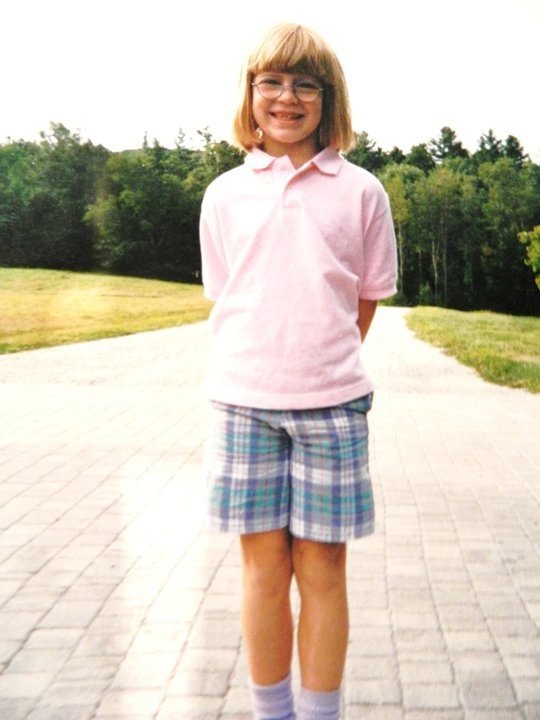Mother’s Day can be a very quiet day at the bookstore. This is actually lovely, because the buildup to Mother’s Day just gets more and more intense as the week progresses. I’ve gone back through our records for the past six years to see what was purchased leading up to Mother’s Day and on the day itself and noticed a few interesting things.
– Men don’t really plan ahead. I don’t mean this in an offensive way at all. It’s just a statement. We had more men in here Friday and Saturday with slightly wide-eyed expressions, looking at books and then asking for help. They always seem surprised that Mother’s Day always falls in May.
– Men pay cash. This week we’ve had triple the number of cash sales than normal. This always strikes me as funny, because these guys use their credit cards during the holidays.
– Men sometimes doubt themselves for no reason. They approach staff saying, “She liked this book,” and they hold a paperback they’ve seen their wife read. This is the part of being a bookseller that I love. There is nothing I like more than helping a someone get the right book for an occasion that is clearly anxiety-provoking. Through speaking with the men, it’s clear they know what their wives like, but for some reason they start to question their taste even though they don’t need to.
– All the books were wrapped in the same paper. For some reason everyone picked the same birds in trees wrap yesterday. This is wrap we’ve had for a year, which we love, but it seldom gets chosen.
– Kids help their dads find cards. It’s actually very sweet to see a grown man checking in with a five-year-old about whether or not he’s picked the right card.
– And, on Monday, we will be full of women discreetly returning the books they got on Sunday, for things they wanted more.
Monthly Archives: May 2013
Coda: Huck Scarry
Elizabeth Bluemle - May 10, 2013
Remember that lovely surprise ShelfTalker enjoyed recently when I posted about a customer sharing a special Richard Scarry book with his toddler and received a comment from the man’s son himself, artist Huck Scarry? In his comment, he asked for our address, and what arrived the other day from Austria was the happiest little piece of art, soon to grace the Flying Pig Bookstore’s walls. First, the envelope, which was almost as marvelous: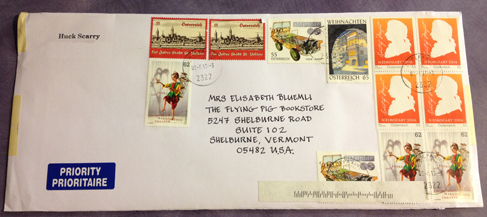

We are feeling very fortunate these days! What a lovely, lovely gift.
If you have a chance, try to track down some of Huck Scarry’s books. In addition to carrying on his father’s timeless work, Huck also has illustrated gorgeous sketchbooks of Tuscany and Venice, as well as intricately detailed tours of life on a fishing boat, travels in a hot-air balloon and a steam locomotive, and more. He’s such an accomplished watercolor and pen-and-ink artist!
Almost nothing delights us more than seeing how children’s book illustrators draw the flying pig. We have received some fabulous pigs through the years, and the aviator Mr. Frumble is a treasure.
It’s been a fabulous week! Enjoy your weekends, everyone.
Grinning ear to ear, your correspondent,
Elizabeth
BEA: What Are You Looking Forward To?
Elizabeth Bluemle - May 9, 2013
I’m not sure if all booksellers do this, but I start planning my BEA (BookExpo America, the biggest annual industry event for publishers and booksellers) weeks in advance. It requires charts and folders, printouts of schedules of panels and signings and educational sessions and cocktail parties and lunches and dinners, and reams of backlist orders. It involves trying to find meeting times with PR folks and grabbing $8 Javits Center coffees with friends and colleagues in the teeny gaps of time left between all the other things. Oh, and then there’s the show floor, where thousands of fall titles will be on display. We need to spend some time there, too.
Usually, Josie and I divide and conquer at BEA, but she can’t make it this year, so I will be pulling double duty trying to schedule and absorb everything. BEA always inspires me, makes me want to read twice as fast, gets me revved up about books and bookselling no matter how challenging the climate in a rapidly changing industry. It’s an opportunity to see booksellers and author and illustrator pals from all over the country, and to meet new ones. It’s a chance to talk with knowledgeable, enthusiastic marketing folks at booths about the fall books they’re most excited about and plan author events at our store.
Things I’m excited about: the Association of Booksellers for Children hosts an annual silent auction of children’s book art. The generously donated pieces are glorious, and proceeds benefit the important work of the American Booksellers Foundation for Free Expression. This year, a rare Maurice Sendak piece is being auctioned off! You can preview all of the art here. The ABC, along with the Children’s Book Council, are sponsoring an author speed-dating session and author tea. The author breakfasts all sound fabulous, there’s a discussion between Kate DiCamillo and Cynthia Voigt I want to hear, and a “Picture Book Powerhouse” panel with Oliver Jeffers, Loren Long, John Bemelmans, Judy Schachner, and Jan Brett. Jon Scieszka, Brandon Mull, and Jack Gantos will be talking about writing for boys, and middle grade and YA editors will be presenting some of their favorite upcoming titles. My friend and esteemed bookselling colleague, Kenny Brechner, will be talking about the Common Core standards and how bookstores can work with schools to support them in thoughtful and fruitful ways. It’s a cornucopia, people!
As for the books themselves, for those of you who are planning to attend BEA, what ARCs are you excited to get your hands on? One of my staffers has already sent me her wish list. What’s on yours?
P.S. Back in 2008 when I was a wee guest blogger for ShelfTalker, I did a post from BEA about how swag-impaired I am. I bemoaned how some people can work the floor for two hours and reappear with rare loot, like jewel-encrusted totes or holographic ARCs or something, while I am the one limping around with blisters, developing a kyphotic hump from lugging around my bag of newly acquired catalogs that probably came in the mail back home. So this year I am determined to come home with one cool item. I am prepared to bribe for tips on likely booth numbers.
“Is He Reading?”
Josie Leavitt - May 8, 2013
I ask this question just about every day. Customers come in seeking books for five to seven-year olds and we often ask “are they reading?” to clarify what section of the store to find books. It is not meant as judgment. I am very quick to let folks know that I really didn’t get the hang of reading until well into my eighth year, so there’s no shame in a seven-year-old who isn’t reading yet.
But there always is. I’m not really sure when it happened that it was expected that every six-year-old should already know how to read. The rush to be on grade-level, even if that grade is kindergarten, is rampant. More often than not the answer to the “is she reading?” is met with a very quick, “She precocious. She’s just finished the Harry Potter series.” Really? At six? Hmmm. I bet every bookseller hears this at least a hundred times a year.
Once I was helping a woman get a book for her son’s friend’s birthday. He was five. I was told he was a very precocious child. I asked if he was reading yet and she said, “Well, not yet.” And I countered with, “Well, then, he’s not that precocious.” I waited for her to get angry with my quip. Instead, she laughed and regrouped on the book idea, settling instead for a lovely Bill Peet book. If you’re not familiar with Bill Peet, go get some of his books.
From Wump World, The Whingdingdilly, Big Bad Bruce to The Caboose Who Got Loose and so many more great titles, his books are playfully illustrated long stories. There is nothing more fun tha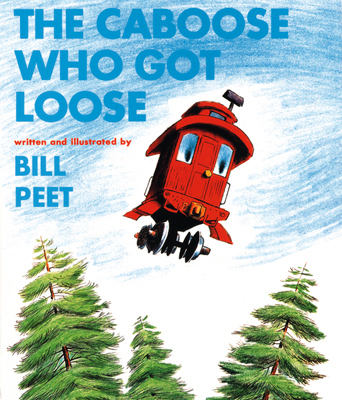 n introducing a family to Bill Peet. His picture books are text-heavy, which is a good thing to get for the older child who isn’t reading yet, but feels too old for picture books. Oh, how I hate that moment when kids eschew picture books because they keep hearing that picture books are for babies. Handing a family a 48-page picture book is a gift. Peet’s books are long and that only makes them skew older. Let’s face it, not many three-year-olds can sit still that long.
n introducing a family to Bill Peet. His picture books are text-heavy, which is a good thing to get for the older child who isn’t reading yet, but feels too old for picture books. Oh, how I hate that moment when kids eschew picture books because they keep hearing that picture books are for babies. Handing a family a 48-page picture book is a gift. Peet’s books are long and that only makes them skew older. Let’s face it, not many three-year-olds can sit still that long.
But the reading question is one all booksellers grapple with every day. We have to ask about a child’s reading level. We are not doing it to judge, we are doing it find the perfect book. Honestly, I think we should steer away from reading levels, but we can’t. If a first grader is reading at first grade level why do some think that’s bad? The kid is in first grade! Let them read at that level and enjoy all the books written for first graders. There is nothing, absolutely nothing wrong with that.
And I love it when people respond to the “Is he reading?” by answering, “No, he’s a regular five-year-old.” That response kind of puts in perspective, doesn’t it?
A Great Galley Mailing
Josie Leavitt - May 6, 2013
One of the things I like best about owning a bookstore is getting galleys in the mail. I never know what lovely discoveries await in the boxes. Sometimes, galleys come with things. Once books were wrapped in feathers (not my favorite galley mailing, as they seem to have disintegrated during shipping). Sometimes galleys come with chocolate, always a staff favorite. Usually though, the mailings 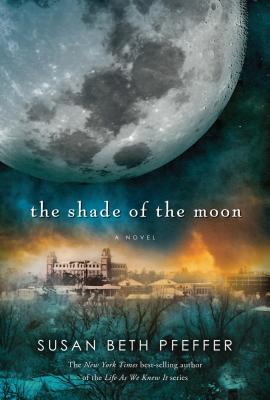 are not useful, until the galley for Susan Beth Pfeffer’s The Shade of the Moon came last week from HMH.
are not useful, until the galley for Susan Beth Pfeffer’s The Shade of the Moon came last week from HMH.
I have to confess that the arrival of this galley actually caused me to do a little Snoopy dance. I just love this series, it started with one of my favorite books, Life As We Knew It. The concept is so simple: what would happen if the moon were struck by a meteor with such force it knocked it off its orbit? Lots of things happen. Things that make the reader want to stock a survival kit in the basement and ensure they have lots of firewood for the weather-related almost-nuclear winter that ensues. All the books in the series are just as compelling as the first, and if the first 100 pages of the new book are any indication, this is going to be another winning entry.
The galley came in a small box with the book and a survival kit. At first I thought, really, a kit? And 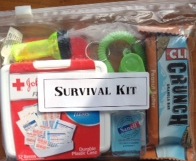 then I opened it. How practical is all of this stuff? I live alone in the country, and this is all very useful. The Clif bar is always helpful when I forget to get food, or eat breakfast. The whistle, well, that can scare bears, right? Matches are always helpful
then I opened it. How practical is all of this stuff? I live alone in the country, and this is all very useful. The Clif bar is always helpful when I forget to get food, or eat breakfast. The whistle, well, that can scare bears, right? Matches are always helpful  when the power goes out. The first aid kit is fabulous and chock full of things to help me when I do something silly, like burn myself with the matches during the blackout. Then there’s hand sanitizer which is also useful when there’s no power and there’s no water.
when the power goes out. The first aid kit is fabulous and chock full of things to help me when I do something silly, like burn myself with the matches during the blackout. Then there’s hand sanitizer which is also useful when there’s no power and there’s no water.
And the best part about this kit is the book, which I cannot put down.
The Best Author Letter Ever
Elizabeth Bluemle - May 3, 2013
You know how life is full of loose ends that never get tied up? Well, the other day, I received the most incredible letter, one that tied up a loose end from almost a decade ago — tied it up not just with parcel string, but with the most glorious big red bow, and I wanted to share it with you all.
Some backstory: several years ago when I was an as-yet-unpublished MFA student, I wrote a picture book manuscript about a little girl who uses her nearsightedness to solve crime. It was called Iris Spectacle: Accidental Private Eye, and I had a deep, amused attachment to it. It skewed old for a picture book, especially these days, with 1500 words and a main character who was eight or nine years old. Still, the story had a certain something; it won a blind picture book manuscript competition that Candlewick Press (not yet my publisher) sponsored through Vermont College. But Iris didn’t sell; at the time, I just wasn’t able to either trim the story to make it younger and drop the crime-solving plot, or expand it into a chapter book. So she sat in a file.
A while later, a librarian on a children’s literature listserv I subscribe to put out a call for books about girls who love their glasses. I sent her a copy of Iris to share with her patron. I never heard whether or not the child liked the story. In fact, I suspected that perhaps Iris hadn’t resonated with the young reader and the librarian just hadn’t had the heart to tell me. Over the years, from time to time, I wondered about the little girl with glasses — the only child who had ever read Iris.
Fast forward almost a decade to the other day, when the most spectacular, funny, beautifully written email arrived in my inbox from that little girl, now seventeen years old. Here is what she wrote (reproduced with her permission):
Hello!
I’m not expecting you to remember me at all, so don’t worry if you don’t. I’d just like to start with that. Anyway. When I was eight I had already spent the previous six years of my life unable to see more than one foot away and even then not very clearly. With some great technology and fabulous doctors I was given these enormous larger-than-harry-potter glasses that barely fit on my face. And I could see, which you think would get me leaping for joy at figuring out the sky is blue, and that there actually is a sky, and all sorts of things. But I was terrified. The world was too big to fathom and I’d rather just make myself a small nook and stay there forever. And then I learned to read. Reading was perfect because I could be in a giant world at the palm of my hands. And I was happy, which I mean was more of a confidence booster to my parents who had this weirdo kid depressed about seeing.
(I’m getting to the part where you come in soon, just hold on.)
Soon I started to love my glasses and being able to see so much that I would not take them off at bedtime until my eyes were closed tight. But as I kept reading with my new-found vision I ran into a problem. There were great children’s books about girls and how great they were and there were great books about boys with glasses and how great glasses were, but nobody seemed to have combined the two. Being an avid fan of both girls and glasses I begged my parents to get me books about girls who had glasses AND loved them, like me. Of course, my parents are not literature experts and had nothing for me, so I enlisted the help of one extraordinary world-class children’s librarian Charlotte Rabbit.
(Okay now I’m getting to your part.)
Mrs. Rabbit found me what was about half a dozen published works that to be honest, eight year old me found really really REALLLLLY REALLLLY boring, as only eight year olds can. So then Mrs. Rabbit sends me something that most definitely isn’t a book. It’s a bunch of white paper clipped together. She told me the book hadn’t been published but I got to read it early. This being the coolest thing that had ever happened in my eight years (besides the whole being able to see thing, which had gotten kind of old at this point) I read Iris Spectacle: Accidental Private Eye about three times in a row. And I loved it. And I brought it to school and bragged about my connections in the literary world and basically felt invincible. Hopefully you remember the book but if not, you wrote it. Anyway finally I had written proof of how cool girls with glasses are. And also a good starting point for my two year detective/spy phase, but that is a whole other story.
Now it is almost ten years later and after some handy dandy googling, I found you and I had to email you to thank you. Even though I guess the story never got published, that’s the least important thing in my mind. Because even if I was teased for having four eyes or I couldn’t make friends because glasses made me look weird, I had that book to read when I got home and know that glasses were good and the world knew it, even if the third grade didn’t know it. Now I am a rather confident high school junior President of a slew of clubs including theatre, and the leadership team, and captain of my ski team. I am a confident actor and very happy in my weird glasses-wearing skin. And I owe a lot of that to you. You and Iris Spectacle were my first friends who didn’t mind the glasses and I can’t thank you enough for that.
Anyway now my long lame-o story is over and I really appreciate that you took the time to read this. And I hope you know that your book, published, unpublished, whatever — it made a difference in my life. Which is all you need to take away from this. If you don’t remember eight year old me or Mrs. Rabbit or that manuscript I stole, it doesn’t matter. This is just a simple thank you.
Thank you.
–Sylvia
********
(Now back to me, Elizabeth.)
Isn’t Sylvia fabulous? This is a kid with moxie, and a way with language. I fully expect to host her at an author signing at the bookstore some day. And if that happens, I will still be glowing from this gift of a letter.
I can’t tell you what it means to an author to hear that her story has helped a young reader in some small way. This is the privilege of writing for children — the joy of connecting with the best people on the planet, through stories and humor and our best attempt to share our hearts on the page.
Thank YOU, Sylvia, for taking the time, all these years later, to find and write to a stranger who once sent a bunch of white paper to a librarian and a little girl far away, and wondered about her. And thank you, Universe, for tying up one of your loose ends.
I Miss Seeing Reps
Josie Leavitt - May 2, 2013
I’ve danced around this topic in other posts, but I just need to come out and say it: I miss seeing sales reps. I email with them, we talk on the phone, etc., but I find that my ordering is scattered at best without actually sitting down and seeing a rep. I know it’s unrealistic to think I can actually see a rep for all my book ordering, but boy, it would be great.
I know with the evolution of on-line ordering, reps are probably far busier than they used to be, but I’ve discovered that frontlist ordering isn’t as successful without me interacting with a rep. Sure, I can do online ordering and read all the notes and the supplemental material, but it takes five times longer than just flipping through a catalog and making notes. What I miss about the meetings are the conversations that begin with, “Let’s go back to page 37. There’s a great paperback original about the relationship between two sisters in New Hampshire that I think your customers would love.” The computer doesn’t speak just to me. The computer doesn’t know my store. My rep does.
Reps are vital to the book business. And a good rep can really help a store if you’re paying attention. I love listening to a good rep (there are bad ones out there, though there seem to be fewer of them out there) talk about the books on the list they love. While I might not agree with all of his or her choices, I love that they have strong opinions about books.
Meeting a rep is a richer experience than sitting at the computer looking at entries. The face to face meeting allows a chance to get to know each other and make each other laugh. Frankly, anyone I’ve laughed with is already way more fun than ordering online. Reps have heart and they love books as much as bookstore staffers do. This love cannot be underestimated. Reps and bookstore employees do not make a lot of money, we all know this. When I walk a rep back to her car and she opens the trunk to reveal a season’s worth of galleys (always try to get a meeting early in the season) and starts handing me things, I get excited about all the possibilities.
Meeting a rep for a meal and then placing an order always seems to take less time than the whole computer order. Maybe that’s because it’s harder to eat and order on the computer than it is in person. Books, while a solitary experience, are also a shared one. We read a book and then give it to our friends and urge them to hurry up and finish it so we can talk about the book with them. Reps are just like that. They encourage us to try new books, to read galleys we might have skipped, and to trust them. It’s the trust that is the cornerstone of the relationship.
And as handy as the computer might be, I’d still always rather sit with a person and talk books.
Diamonds, Balloons, Hidden Worlds, and Dragons
Elizabeth Bluemle - May 1, 2013
 Every year, I like to resurrect at least a few favorite older books to recommend for summer reading.
Every year, I like to resurrect at least a few favorite older books to recommend for summer reading.
The 21 Balloons by William Pène du Bois (Viking) is a perennial favorite because it includes a hot-air balloon wreck at sea, diamond mines, an exploding volcanic island, and best of all, scads of whimsical inventions in the houses of the secret civilization on Krakatoa, where the shipwrecked main character washes up.
Beds that rise through skylights so kids can sleep outdoor at night.
The author was also an incredible artist, and his depictions of inventions mesmerized my sister and me when we were kids. We were fascinated by the living room with chairs connected to overhead electrical grids so they could zoom around the room, and beds whose sheets could be wound to new freshness on a big roll (like old-fashioned cloth handtowels that used to be in public restrooms), and the clever balsa-wood items that replaced regular items too heavy for hot-air balloon travel. The book has a slow beginning, especially for 21st-century attention spans, so I let kids know that ahead of time, showing them some of the great illustrations, and reassure them that once the Professor gets up in his balloon, there’s clear sailing ahead — for the reader, at least.
 Finally, Rebecca Rupp’s absolutely charming Dragon of Lonely Island (Candlewick) is always, always a hit with kids ages 7-10. It combines everything you want in a summer story: adventure, humor, the sea, and of course dragons. Well, one glittering golden dragon with three heads, who is quite old and sleepy, but kind. It befriends the three children who discover its cave, drawing them in with riveting stories about past adventures from its 20,000 years of life. While the children get a taste of ancient China, at sea in 19th-century England, and a plane crash in early 20th-century America, they also realize that someone else has discovered Fafnyr’s den and wants to kidnap their dragon friend.
Finally, Rebecca Rupp’s absolutely charming Dragon of Lonely Island (Candlewick) is always, always a hit with kids ages 7-10. It combines everything you want in a summer story: adventure, humor, the sea, and of course dragons. Well, one glittering golden dragon with three heads, who is quite old and sleepy, but kind. It befriends the three children who discover its cave, drawing them in with riveting stories about past adventures from its 20,000 years of life. While the children get a taste of ancient China, at sea in 19th-century England, and a plane crash in early 20th-century America, they also realize that someone else has discovered Fafnyr’s den and wants to kidnap their dragon friend.There are so many others I could write about: Edward Eager’s Magic or Not?, Anne Lindbergh’s Worry Week (Josie’s favorite summer book to recommend to ages 7-10), the more serious Island of the Blue Dolphins by Scott O’Dell, and on and on.
What backlist books about vacations, adventures, sand, sea, and sunshine put you and the kids you recommend to in a summer mood?

